Alec Bray

Some programmes have as much an effect on the people who work on it as they do on the audience who watch it. One such programme was “The Idiot” (1966). This was an adaptation by Leo Lehmann of the novel by Fyodor Dostoevsky.
Crew 14 was the crew for “The Idiot”: the Senior Cameraman was Dave Mutton. This was during a relatively brief spell on crew 14 for me, as I spent most time on crews 7 and 13 (and occasionally 16!). Most of the 5 episodes were done in R1, but episode 2 was done in TC1.
Working on this programme quite affected me – I was absorbed by this production. I was able to collect and keep the Camera Scripts for episodes 1 and 2 – now on the Tech Ops website as PDFs (here: episode 1 and episode 2). After the series, I immediately purchased “The Idiot” and “The Brothers Karamazov” – and basically got fully involved with Dostoevsky, reading many of his other stories and novels, especially, of course, “Crime and Punishment”.
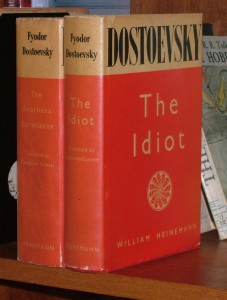
+++++++++++++++++++++++++++++++
About the programme “The Idiot”
Little information remains about this production (as with so many others made about this time) (although see end of this story – the BBC Archives). Here is some information we have found about “The Idiot”.
Alec Bray
(with contributions from David Brunt, Paul Kay, Roger Bunce and Bernie Newnham)
Background
“The Idiot” (Russian: Идиот, Idiot) was written by the 19th-century Russian author Fyodor Dostoyevsky. It was first published serially in “The Russian Messenger” between 1868 and 1869. “The Idiot” is often considered one of the most brilliant literary achievements of the “Golden Age” of Russian literature.
Crew
The Director was Alan Bridges.
Other people involved on the technical side were:
| TM1: | Bob Wright |
| TM2: | Clive Thomas |
| Sound Supervisor: | Richard Chubb |
| Grams Op: | Clive Gifford |
| Vision Mixer: | Joan Duncan |
| Senior Cameraman: | Dave Mutton |
The Grams Op on episode 2 was Chris Carne (the only change on technical personnel between episodes 1 and 2)
Other credits include:
Designer: Tony Abbott
Producer: Douglas Allen
Episodes
Unfortunately, there is no reference to this production in Wikipedia although there is a reference in IMDB where the production is referred to solely by the subtitle for the first episode: “The Prince’s Return”. This unfortunately lists everyone (including cast, scriptwriter and director) as working on just this one episode of the series (and additionally has an incorrect graphic).
The “Kaleidoscope Drama Guide” (BBC) does include some information about “The Idiot”: a BBC production for BBC 2, with a usual duration for each episode of 45 minutes. Kaleidoscope are archive specialists who work with the broadcasting companies, tracking down and restoring ‘missing’ programmes. Kaleidoscope lists the episodes (and episode subtitles) as:
| TX date (BBC2) | Episode | Subtitle | Archive Exists |
| 11.01.1966 | 1 | The Prince’s Return | Yes |
| 18.01.1966 | 2 | The Auction | NO |
| 25.01.1966 | 3 | The Trees Of Pavlovsk | Yes |
| 01.02.1966 | 4 | The Illusion | Yes |
| 08.02.1966 | 5 | Death After A Wedding | Yes |
Episode 2 does not exist in the archives, though the other 4 episodes, according to the Kaleidoscope information, do exist in the archives and are 16mm black and white film recordings from live transmission. The film recordings of all five were almost certainly sold overseas (most likely to Australia, as at the time Australia took a great deal of the BBC’s output), but only the four surviving episodes were later sent back when their licence expired. It is probably only by luck that even four shows survive – some other shows from the same period have no surviving episodes.
However, the “Kaleidoscope Drama Guide” may not be a completely an accurate source.
Episode 2, according to the Camera script, was subtitled “A Party at which a Woman was Bought” (not “The Auction”): here is the relevant part of the script:

It would have been very, very difficult to change this in post production (and at this time there was very very little done in the way of post-production work for Television material), although the production did have to buy the videotape as there was a recording break to reset for Lebediev’s hovel (needed for actor moves and camera moves – every one of the 5 cameras moved to a different floor position).
Kaleidoscope “fact check” every detail of their books very well, so it may be that the episode subtitle was changed very late in the day and not reflected on the camera script. Cast credits slides were often changed right up to the transmission/recording.
However, the CAPTION as used at this time was printed WHITE on a black background (as were all such captions, including the roller captions at the end of the programme) , so that it could be superimposed on a suitable background (here, the main title graphic): presumably there was some “lead time” in the production of the caption, so that if there had been a late change, it could have been reflected in the Camera script. The production was very well organised and there is evidence that the duplication of the script for episode 1 had been changed (to include the “Maid” character) so if there had been a change in subtitle it would most likely have been reflected in a script change for episode 2, if necessary. Alas, as episode 2 does not exist, we will never know!
Further, the second episode – the one marked as missing in the “Kaleidoscope Drama Guide” – was Film Recorded at the same time as the VT recording (and not off-air): the recording details are:
RECORDING: (VT/6T/30377 & 16/6ENT/30377) 7.30 – 9.45
By the way, the project numbers were:
2324/3179 (episode 1)
2324/3180 (episode 2)
so at some stage it definitely existed on film!
The first episode was recorded on 8th December 1965 (from Riverside 1) and transmitted on 11th January 1966.
Scripts and Story
Camera Scripts:
The PDFs for Episodes1 and 2 have already been referenced (thanks to Bernie) but they are also referenced here for convenience.
A royalty-free download of the complete novel “The Idiot” is available here:
The Idiot by Fyodor Dostoyevsky.
The Cast
Unusually, the cast included many actors from theatre, rather than actors well used to television. I am not sure whether the crew was told during initial notes, or over talkback, or through gossip, but we were warned that some of the cast were not used to working in Television, so be careful! The actors or actresses might not always hit their marks.
Adrienne Corri (later to gain notoriety as the woman in the red catsuit who is gang-rape by Alex and his Droogs in “A Clockwork Orange”) played Nastasia Philipovna. Nastasia was one of the two women involved with Prince Myshkin.
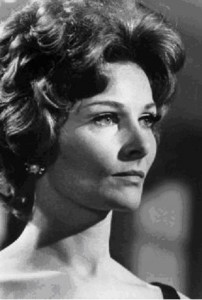
Other cast members included David Buck, Anthony Bate and Shirley Cain. David Buck played Prince Myshkin.
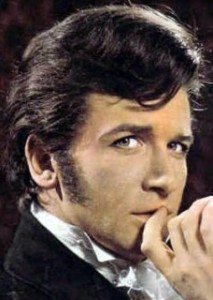
There were some actors who we, as a crew, knew well from their work in television, including Patrick Newell: I shall always remember Patrick Newell (playing Lebediev), sitting in the railway carriage set, tapping his nose and saying “Lebediev knows, Lebediev knows”.

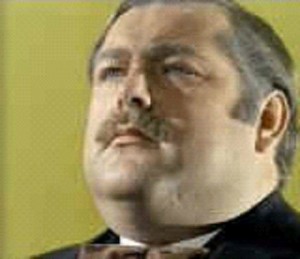
The main regular cast was:
| Actor | Character | |
| David Buck Adrienne Corri Anthony Bate Patrick Newell John Kelland | Prince Myshkin Nastasia Rogojin Lebediev Gavrili | |
| Michael Goodliffe Ambrosine Phillpotts Marian Diamond Elizabeth Counsel Suzan Farmer | General Epanchin Lizaveta Epanchin Alexandra Adeline Aglaia |
Other actors include:
| TX Date | Episode | Part Subtitle |
| 11.01.1966 | 1 | The Prince’s Return |
| Joan Geary Henry Manning Shirley Cain Derek Carpenter Bernard Kay |
| TX Date | Episode | Part Subtitle |
| 18.01.1966 | 2 | A Party at which a Woman was Bought |
| Hazel Bainbridge Noel Coleman Richard Burrell Bernard Kay |
| TX Date | Episode | Part Subtitle |
| 25.01.1966 | 3 | The Trees Of Pavlovsk |
| John Carlin David Weston John Forgeham Jon Laurimore Hywel Bennett Richard Coe |
| TX Date | Episode | Part Subtitle |
| 01.02.1966 | 4 | The Illusion |
| Frank Shelley Derek Carpenter Hywel Bennett Frederick Piper David Weston |
| TX Date | Episode | Part Subtitle |
| 08.02.1966 | 5 | Death After A Wedding |
| Hywel Bennett David Weston Hazel Bainbridge John Forgeham Jon Laurimore Justin Walters Lala Lloyd John Carlin |
Hazel Bainbridge’s appearances in episodes 2 and 5 are not credited in the IMDB.
It is of interest that for both episodes 1 and 2 there was a photo call for the artists on the first day of rehearsals between 7;15 and 8:00 (19:15 and 20:00) – but I have as yet not found any of these pictures published on the Internet under the TV series or the actors’ biographies.
——
One example of the care taken by the cast (and, for some, their relative inexposure to television) concerns a large Chinese Vase. The incident is described in the novel in Part 4 Chapter 7:
… “Do break something at least, in the drawing-room! Upset the Chinese vase, won’t you? It’s a valuable one; do break it. Mamma values it, and she’ll go out of her mind—it was a present. She’ll cry before everyone, you’ll see! Wave your hand about, you know, as you always do, and just smash it. Sit down near it on purpose.”
“On the contrary, I shall sit as far from it as I can. Thanks for the hint.”
…
[Myshkin] took the chair nearest to the beautiful vase, which stood on a pedestal behind him, just about on a level with his elbow. As he spoke his last words he had risen suddenly from his seat with a wave of his arm, and there was a general cry of horror. The huge vase swayed backwards and forwards; it seemed to be uncertain whether or no to topple over on to the head of one of the old men, but eventually determined to go the other way, and came crashing over towards the German poet, who darted out of the way in terror.
The crash, the cry, the sight of the fragments of valuable china covering the carpet, the alarm of the company—what all this meant to the poor prince it would be difficult to convey to the mind of the reader, or for him to imagine. …
The Project Gutenberg EBook
Translator: Eva Martin
Release Date: May, 2001
[EBook #2638]
Last Updated: January 26, 2013
This scene was in an episode recorded in Riverside 1: the set was towards the Gallery end of the studio. Of course, there was only one Vase, so on the rehearsals, the Vase was not smashed – but on transmission it had to fall and smash – and fall and smash correctly.
David Buck (Myshkin) (actually standing near the Vase, not sitting) had to grab hold of a string attached to the Vase and physically pull it off the pedestal on which it was standing. At some stage before recording this scene – it may have been during the final run through – David asked the other members of the cast to help him with the Vase: he was concerned that he would get so involved in the performance that he would forget the string, so he asked the “crowd” to make sure that the Vase got toppled.
In the event, David yanked on the string at the correct moment and the Vase fell and smashed as required.
Opening Titles
The opening titles consisted of a (pedestal) crab along a wide photo-blowup (PBU) of Hans Holbein’s “Christ in the Tomb” with captions superimposed. As I recall, it was a black and white PBU (as would be expected) but was more of a line drawing rather than a full tone reproduction – something like this unidentified silverpoint copy:

It is of interest that the title sequence used Studio TV cameras to do this track (crab) along the length of the picture, rather than have the titles on film shot using a rostrum camera.
The reason for using this picture is that Dostoevsky saw this painting in Basel in 1867 and incorporated it into “The Idiot”. His wife, Anna Grigoryevna (Snitkina), wrote about this in her diary (entry of 12/24 August 1867), specifying that Dostoevsky had made a detour especially to see that picture, looked at it for some 15 to 20 minutes, even climbed on a chair to examine it in more detail (it hung quite high upon the wall) and that he appeared on the brink of an epileptic fit when she found him.
The size of the painting is about 30.5 x 200 cm, that is, about the size of a cross section through an actual coffin. The body shows obvious signs of corruption, especially around the wounds, the face and the extremities. Apart from the stigmata, though, it appears unharmed – there are no signs of the whip, nor of the crown of thorns.
Holbein completed it in 1521. The painting is lifelike in size, measuring 2 metres long and just 31 centimetres high (79 inches x 12 inches) and depicts the dead Christ lying stretched and unnaturally thin in a wooden tomb. The dimensions of the painting create a disturbing effect. The painting has an almost claustrophobic shape. Holbein’s portrait of the dead Christ is probably as shocking a picture as one is ever likely to come across.
The painting made such an impression on Dostoevsky that he wove interpretations of this picture into “The Idiot” on which he was working at that time. The painting is first introduced quite early in the book in Part 1 Chapter 5, but as yet without any description.
The main description is in Part 2 Chapter 4: Dostoevsky represents this as an image of Christ just taken down from the Cross although the painting itself shows a decaying corpse.
————————
CHAPTER IV
THEY went through the same rooms that Myshkin had passed through already; Rogozhin walked a little in front, Myshkin followed him. They went into a big room. On the walls there were several pictures, all of them portraits of bishops or landscapes in which nothing could be distinguished. Over the door leading into the next room there hung a picture of rather strange shape, about two yards in breadth and not more than a foot high. It was a painting of our Saviour who had just been taken from the cross. Myshkin glanced at it as though recalling something, but he was about to pass through the door without stopping. He felt very depressed and wanted to get out of this house as soon as possible. But Rogozhin suddenly stopped before the picture.
“All these pictures here were bought for a rouble or two by my father at auctions,” he said. “He liked pictures. A man who knows about paintings looked at all of them. ‘They are rubbish,’ he said; ‘but that one, that picture over the door there, which was bought for a couple of roubles too,’ he said, ‘was of value.’ When my father was alive one man turned up who was ready to give three hundred and fifty roubles for it; but Savelyev, a merchant who is very fond of pictures, went up to four hundred for it, and last week he offered my brother Semyon Semyonovitch five hundred for it. I’ve kept it for myse1f.”
“Why, it . . . it’s a copy of a Holbein,” said Myshkin, who had by now examined the picture, “and, though I don’t know much about it, I think it’s a very good copy. I saw the picture abroad and I can’t forget it. But . . . what’s the matter?”
Rogozhin suddenly turned away from the picture and went on. No doubt his preoccupation and a peculiar, strangely irritable mood which had so suddenly shown itself in him might have explained this abruptness. Yet it seemed strange to Myshkin that the conversation, which had not been begun by him, should have been broken off so suddenly without Rogozhin’s answering him.
“And by the way, Lyov Nikolayevitch, I’ve long meant to ask you, do you believe in God? ” said Rogozhin suddenly, after having gone on a few steps.
“How strangely you question me and . . . look at me!” Myshkin could not help observing.
“I like looking at that picture,” Rogozhin muttered after a pause, seeming again to have forgotten his question.
“At that picture!” cried Myshkin, struck by a sudden thought. “At that picture! Why, that picture might make some people lose their faith.”
“That’s what it is doing,” Rogozhin assented unexpectedly. They were just at the front door.
“What?” Myshkin stopped short. “What do you mean? . I was almost joking, and you are so serious! And why do you I ask whether I believe in God? “
“Oh, nothing. I meant to ask you before. Many people don’t believe nowadays. Is it true – you’ve lived abroad – a man told me when he was drunk that there are more who don’t believe in God among us in Russia than in all other countries? ‘It’s easier for us than for them,’ he said, ‘because we have gone I farther than they have.’ . . .”
Translation by Constance Garnett (1913)
reset 1946 and reprinted 1964,
Published by Heinemann, London
Part II Chapter 4 pp 211-212
————————
In the Script for Part 2, this becomes:
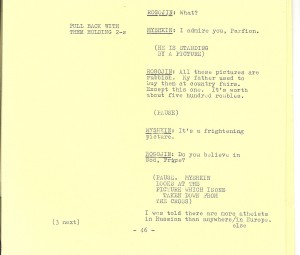
Studios used
The main studio used was Riverside 1 (R1) but for episode 2 the production moved to TC1. For this episode there was as a grand sweeping staircase as part of the set, extending up towards the lighting gantries. I seem to remember Adrienne Corrie sweeping down this staircase. This staircase had an important part to play in the story.
Although we were in TC1, the floor area used was that for R1 – and all cameras had to stay within this area as if we had been in R1: this was made very clear to the Tech Ops crew! We were not allowed to use all of TC1 and stray into the wider studio space: for example, we could not loosen a wide shot if it meant straying outside the “boundaries”.
At the time that I joined BBC tech Ops (January 1963), the BBC provided facilities (such as VT and TK) that the productions could use as needed. Costs at this time were “above the line” and “below the line”. A studio was below the line, and if a specific studio (eg TC1) was free and a crew available a production could have it for the cost of a project number: it was there and it had been paid for. However, I seem to recall some discussions about this time concerning a different costing system, called, at the time, (at least colloquially by the production people) as “phantom costing”.
There may have been another reason for the “boundaries”. Although in later years a small show that was put into a large studio, for convenience, was supposed to restrain itself to the floor area the production had paid for. But 1966 sound too early for the sillier costing policies.
The restriction in the case of “The Idiot” may have been self-imposed for artistic reasons. All episodes, exceptepisode 2, were shot in R1. The dimensions of R1 would have restricted the width of the shots that could be taken. In TC1 it would have been possible for cameras to track back further and take wider shots. But it would have been illogical and inconsistent for one episode to have wider shots than all the others, particularly if shooting the same sets. So the Director may have asked his cameras to stay within the footprint of R1 in order to ensure consistent perspective and shot sizes throughout the whole serial.
There is another possibility. A whole range of shows of all kinds had to be set up so that they would fit in a “standard” studio – 3, 4,6 or 8, or Riverside 1 or Pebble Mill, depending on the year. In those days budget was secondary to expediency, and so shows could be shifted even quite late around the standard options to suit others which had more particular needs or to suit durations of studio time required. Shows which could only be done in TC1 were allocated there first, and if there was space in the schedule, other standard sized shows could be put there.
In this case, the production of “The Idiot” had been designed and set up for studio space equivalent to R1 – so that is what they used. But the one set in TC1 that did not appear in other episodes was a grand staircase (which figured centrally in the episode 2 denouement) and we could have well used the extra space!!
Direction
My recollection of the production and direction was that it was simply competent. There were no histrionics from the cast or crew, nothing went wrong on recording.
There was not too much free space in the studio (R1) as we had good sized sets, but there was no problem with camera moves – it had all been thought out very well.
Episode 2 keeps cropping up! For a production which was very well planned, the last scene of episode 2 was worked out on the studio floor (in my experience of drama and series productions, this was rather unusual). In the Running Order it says that the last shots are to be directed in the studio:

This is at another critical moment in the story. Myshkin is climbing the staircase in the hotel when Rogojin tries to kill him – but is thwarted as the Prince falls into an epileptic fit.
The Camera script has no shots marked for this scene – the shot sequence was constructed during the stagger through.
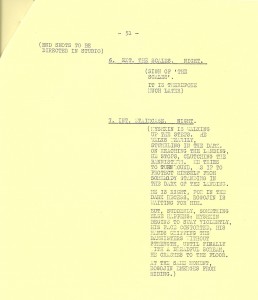
+++++++++++++++++++++++++++++++
BBC Archives …
Alec Bray
I contacted the BBC Written Archives Centre (address below) to offer them the papaer copies of the two episodes 1 and 2 that I had kept.
Louise North, Archives Researcher in Information & Archives, searched through the BBC Archives and has written:
“… I can set your mind at ease by confirming that we hold scripts for … parts 1-2 of “The Idiot”.
We also have programme files for each of the five parts of “The Idiot” in our collections, so the state of information about these programmes is not as sparse as you fear…”
Louise North
Archives Researcher
Information & Archives
BBC Operations
BBC Written Archives Centre,
Caversham Park,
Reading RG4 8TZ.
Tel External: 0118 948 6158
Tel Internal: 01 86158


